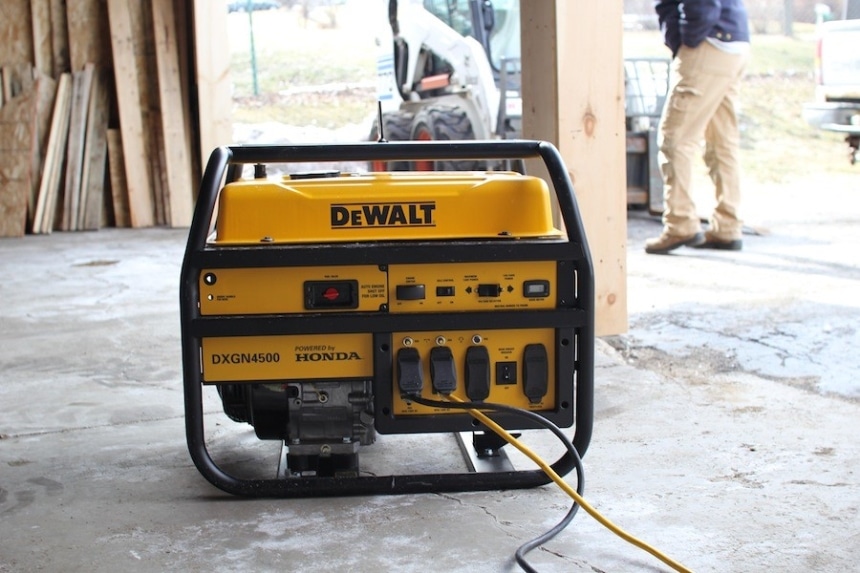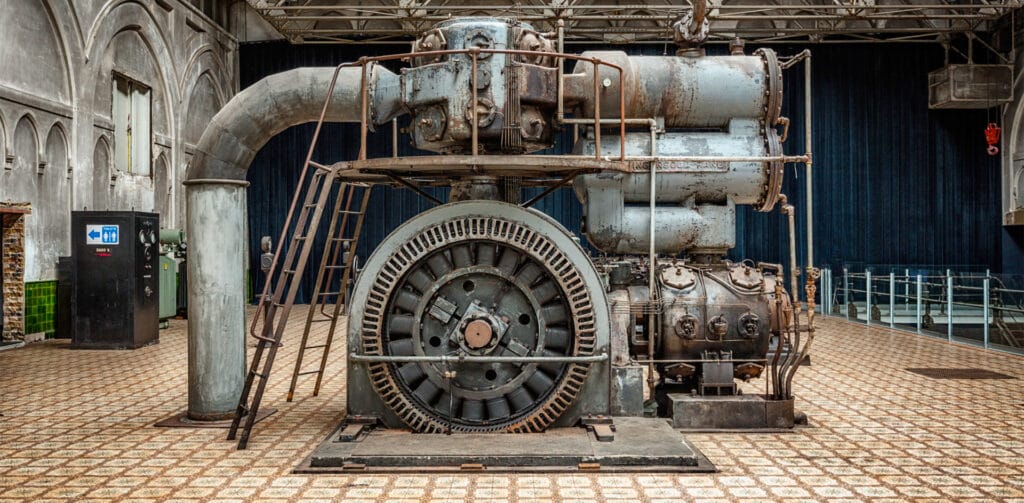
DeWalt is one of the best-known brands in home improvement and construction. The company is renowned for the longevity and power of its tools and equipment, and it doesn’t hurt that DeWalt offers excellent customer service to boot. So, if you’re looking for a generator, it should come as little surprise that DeWalt offers some of the best models on the market.
In order to pick the best DeWalt generator, we looked at 10 of the company’s models and read through numerous DeWalt generator reviews. Ultimately, we landed on the DEWALT DXGN7000 as our Editor’s Choice. This generator boasts a ton of power and has several nice features for ease of use and portability. Of course, we couldn’t just review one generator – you’ll find reviews of three other DeWalt models to help you choose the best generator for your needs.
There was a lot to consider when picking the best DeWalt generator. Those different generators fit different budgets, power output needs, and applications. In addition, the runtime was an important factor, especially if you need a DeWalt generator for all-day projects. We spent tens of hours poring over customer reviews and technical specs to select the top four DeWalt models. You’ll find our picks in the table below, followed by detailed reviews. Keep reading for our buying guide, which covers everything you need to know about choosing the best DeWalt generator.
The DXGN7000 is the largest and most powerful DeWalt generator we reviewed. Surprisingly, it’s also one of least expensive models because it uses a DeWalt-made engine rather than a more expensive Honda engine. Users who have put this generator to the test found that the performance is indistinguishable, though, and the generator’s engine has continued to work even after being put through the wringer.
The amount of power this generator can put out is pretty impressive in its own right. It can continuously produce 7,000 watts, and it has surge capacity for up to 8,750 watts. To put that in perspective, it’s more than enough to power most standard homes during a power outage and offers enough power for even the most active jobsites.
The only major drawback to this generator is that the runtime is somewhat short compared to DeWalt’s other models. It can run for 11 hours at half load, but you’ll only get about five hours of power if you need all 7,000 watts.
Still, users love the fact that it comes with six outlets, two of which are capable of delivering 240-volt, 30-amp power. The LCD wattage and runtime meters are also extremely helpful for monitoring your power load and remaining fuel.
The generator is heavy at 192 pounds, but it actually doesn’t add much weight over DeWalt’s smaller models. In any case, it’s mounted on sturdy pneumatic wheels, so you should have no problem towing it off-road.
For contractors in need of a portable power unit, the DeWalt DXGN6000 packs a punch. This generator can deliver 5,300 watts of continuous power or 6,000 watts of surge power, which is just the right amount for most small- and medium-sized jobsites.
Importantly, this generator has no shortage of outlets. There are two sets of 120-volt outlets and both duplexes are backed by a grounded GFCI circuit for added electrical safety. There’s also a 30-amp twist-lock outlet and a second twist-lock outlet that can output 240-volt power. That outlet is particularly important if you need to work with heavy-duty power tools like contractor saws, since many of these rely on 240-volt power.
DeWalt built this generator with a generous eight-gallon tank, which gives it a 14-hour runtime at a 50% load. That’s a major plus in and of itself, since it means you can get almost a full day’s worth of work in without having to stop and refuel this generator.
That said, this generator is missing a few features that would make it easier to use. Unlike most of DeWalt’s other large conventional generators, it doesn’t include an hour meter to allow you to monitor your power draw or remaining fuel. It also lacks an electric starter, although users noted that the recoil starter is very reliable.
Thankfully, the generator is plenty portable. The frame features fold-out towing arms, and the whole generator is mounted on a set of pneumatic wheels that can easily handle uneven terrain.
The DXGN4500 may be one of DeWalt’s smallest generators, but it’s also a relatively premium model. To start, the generator is built around a Honda GX270 engine rather than a DeWalt engine. Honda is one of the most experienced engine companies in the world and it is renowned for the longevity and quiet of its generator engines in particular. So, you can be confident you’re getting an extremely durable and high-performing engine inside this model.
DeWalt continued to pack this generator with features, including plenty of outlets. Like the larger DXGN6000, it includes two sets of GFCI-grounded 120-volt outlets, a 30-amp twist-lock outlet, and a 120-volt/240-volt outlet. That variety means that you can use this generator for everything from RVing to worksites.
The generator also includes a few extra features that we were happy to see. For example, it has a digital hour meter so you can monitor the amount of power you’re drawing and the remaining runtime. It also includes an electric start function, which makes it easier to get the generator running quickly.
For a 4,500-watt generator, a seven-gallon fuel tank is quite large. That gives this generator an impressive 15-hour runtime at half-load, which is something you won’t find on many competitors.
Notably, this is either DeWalt’s most or least portable generator depending on your perspective. The fact that it doesn’t have wheels makes it impossible to tow without a cart, but at the same time it’s just light enough that two people can carry it by the frame. The frame also has a tow hook, which is particularly helpful if you have a way to hoist the generator into a truck bed or onto the upper floor of a construction project.
The DXGNR5700 isn’t DeWalt’s most powerful conventional generator, but it does boast a very impressive surge wattage. While this model can only put out 5,700 watts continuously, it can produce a whopping 1,400 extra watts on demand to help you startup a power tool or appliance.
Part of the reason it can do that is the DeWalt engine under the hood. It has a displacement volume of 389cc, which is almost as much as the DeWalt engine in the much more powerful DXGN7000. Using a DeWalt engine as opposed to a Honda engine also keeps the price of this generator very reasonable. In fact, it’s one of DeWalt’s best options for homeowners and contractors on a budget.
The generator is lighter on outlets than the other DeWalt models we looked at, although it still covers the essentials. It has two 120-volt duplexes, which are wired to reset switches in case you blow a fuse. But, keep in mind for commercial applications that these outlets are not protected by a GFCI circuit. The other outlet is a 120-volt/240-volt twist-lock outlet, which can also be used to connect the generator to an RV with an adapter.
This generator has a slightly small fuel tank for its size, which limits its runtime to just 10.5 hours at half-load. You can monitor your remaining fuel with the digital hour meter, though. Users also appreciated the electric start function, although they found that the recoil starter worked reliably on the first or second pull.
Now that you’ve learned more about our four favorite DeWalt generators, how do you decide which one is right for your needs? Our buying guide will cover all the essentials you need to consider when picking a generator, from the difference between inverter and conventional models to deciding how much power you want.
Before we dive into the details of choosing a specific generator model, why choose DeWalt specifically? The company has a lot of fans all over the world, and it’s more than earned its accolades over the years.
To start, DeWalt tools are known for their durability. Every DeWalt tool is built with a tough, weather- and dust-resistant casing. For generators, that durability and construction quality is extremely important because it ensures that your equipment can stand up to whatever conditions you throw at it.
Another big plus to DeWalt is the company’s experience with building motors and engines. DeWalt has long dominated the market for small electric motors in the power tool market, and its engines aren’t far behind. DeWalt still can’t compete with the likes of Honda and Yamaha, companies with decades of experience building generator engines, but it comes impressively close while charging a fraction of the price.
Finally, DeWalt is widely used and offers excellent customer service. If you ever have a problem with your generator, you can be confident that you’ll be able to get help – either from your local equipment tech or from DeWalt’s own technical service team.

However, inverter generators are also much more expensive than tried-and-true conventional generators. The extra harmonic distortion that conventional generators produce isn’t an issue for most power tools, so that negates the major advantage of inverter generators for many shop owners and contractors. Conventional generators are also capable of producing much higher wattage than inverter generators, which is a plus if you need to run heavy-duty tools and equipment.
DeWalt largely focuses on conventional generators. In fact, all four of our top picks are conventional models.
The next big question you need to ask yourself is how much power you need. More is better, since you can always use less power than your generator is rated for, but never more. However, you don’t want to go too crazy since excess power increases your purchase cost, your fuel cost, and the weight and noise of your generator.
The best way to figure out how much power you actually need is to think about what tools or appliances you plan to run with your generator. The wattage of everything you might want to run at one time should add up to less than the continuous or rated wattage of your generator. The DeWalt models we reviewed range in continuous output from 4,200 to 7,000 watts.
If you have a motor-driven tool or appliance, like a table saw or refrigerator, you’ll also need to consider how many watts the motor draws when starting. This extra power demand can be accommodated by the surge wattage of your generator, which is the power it can hold for several seconds.

How much runtime you need depends on your application. Contractors needing to power tools all day long might demand a runtime of eight hours or more at full load, while homeowners may need longer runtimes at lower loads. Keep in mind that once you run out of fuel, you need to let the generator fully cool down – so refueling can mean 30 minutes or more without power.
Modern generators, including all DeWalt models, have a few important safety features to protect you and your generator. For example, you’ll find that all the DeWalt generators we reviewed will automatically shut off if the engine oil gets too low. They also have overload prevention. In effect, the generator will shut off if you try to draw too much power rather than try to work too hard and potentially damage the engine.
DeWalt generators aren’t cheap. While they aren’t nearly as expensive as competing models from vaunted companies like Yamaha and Honda, DeWalt models are definitely not the most budget-friendly options around.
However, keep in mind that you get what you pay for when it comes to generators. It’s less expensive in the long run to buy a quality DeWalt generator that will last for years than settle for a cheap competitor only to have it break down after one season.
Our three favorite DeWalt generators on the market today are the DXGN7000, the DXGN6000, and the DXGN4500.
The DXGN6000 and DXGN4500 are both built with durable Honda engines inside, although this also makes them relatively expensive for the amount of power they put out. These two generators also include a wealth of outlets and back their 120-volt duplexes with GFCI circuits.
We think the DXGN7000 is the best DeWalt generator for most users, though, because it’s a more affordable option that puts out more power. The DeWalt engine seems to be just as reliable and long-lasting as Honda engines. We also liked that the DXGN7000 comes with some ease of use features like an electric starter and two LCD displays.






Where are DEWALT generators made?
DEWALT’s primary production location is in Shreveport, Louisiana. Apart from that, they have smaller operations in Kansas City, Missouri, and Cancun, Mexico. They also have a generator factory in Jacksonville, North Carolina that produces 1400-watt generators for diesel engines.
My DEWALT DXGNR8000 is not producing any power. What do I do?
First, make sure that there are no blockages around it. Then check the gas tank of your generator to make sure it is full of fuel. Check the oil levels in your generator. If they are running low, fill them up. If you hear any weird sounds coming from the generator, stop using it. Get it checked up on as soon as possible.
I’d also recommend to check if power outlet is working by plugging in a different appliance that you know is working, like a lamp or something. If this is not the case, you may need to change the fuse or circuit breaker. If you don’t know how to do this, refer to your user manual for instructions. If none of these things work, contact your generator manufacturer for help. If they can’t fix the old one, you will obviously need a new generator. But it would be good to find out what exactly went wrong with the old one before getting a new one!
Can the DEWALT generators use synthetic oil?
DEWALT say you can use synthetic oil in their generators; however, it is not necessary as 10W-30 oil would also work.
Which one is better for use at home, a regular generator or an inverter?
Inverters are better than conventional generators for household use. They don’t need as much maintenance and they can run for years. Conventional generators are better if you are running a company because they make more energy. There are many benefits of using an inverter instead of an ordinary generator.
Conventional generator and inverter both have their pros and cons. Inverters are really quiet, they switch from the main power to inverter impressively fast (in less than 5 milliseconds!), you can use them with a solar system to provide free power throughout the day. There is also very little maintenance necessary other than cleaning dust filters and refilling battery acid. At the same time batteries for inverters can be quite pricey and replacement of the battery is highly expensive, especially if the inverter is seldom used (the battery has not been cycled). As for conventional generators, they are flexible and may be used in various locations (at home, among friends, by the beach), they also can run for a long time as long as there is enough gas. But they are much noisier than inverters, need more maintenance and you can’t use them indoors. Besides, there is a delay between the loss of electricity and the restoration of power. Inverter was my preferred option since I already have solar panels and produce my own power during the day. It all boils down to your specific needs. I live in a region that receives lots of sunshine throughout the year. As a result, a solar system was ideal for me.